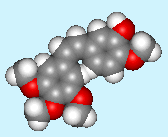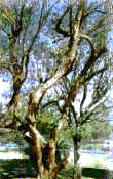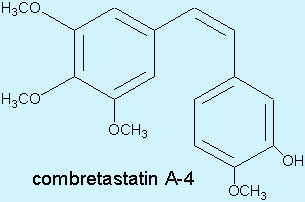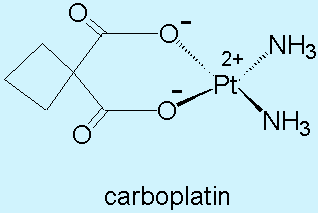![]()
 |
Combretastatin A-4 |
![]()
![]()
Also available: HTML-only, VRML and JMol versions.
![]()
 Combretastatin is a small organic molecule found in the bark of the African bush willow tree Combretum caffrum (photo, right), identified 21 years ago by Professor George R. Pettit, the Director of the Cancer Research Institute based at Arizona State University in the USA. (See Pettit et al. Can. J. Chem. 610 (1982), 1374). Scientists at the CRI have not only completed a total synthesis for combretastatin, but have isolated it on scales large enough to allow clinical testing, and they have also produced water-soluble phosphate derivatives, which are helping the drug's delivery to patients. Professor Pettit, like many great scientists, is driven towards a goal, that of finding treatments for cancers. He has many lead compounds and is a well-known scientist in the world of Natural Products Chemistry. I had the pleasure of working with the legendary "medicine man" from 1992-1994.
Combretastatin is a small organic molecule found in the bark of the African bush willow tree Combretum caffrum (photo, right), identified 21 years ago by Professor George R. Pettit, the Director of the Cancer Research Institute based at Arizona State University in the USA. (See Pettit et al. Can. J. Chem. 610 (1982), 1374). Scientists at the CRI have not only completed a total synthesis for combretastatin, but have isolated it on scales large enough to allow clinical testing, and they have also produced water-soluble phosphate derivatives, which are helping the drug's delivery to patients. Professor Pettit, like many great scientists, is driven towards a goal, that of finding treatments for cancers. He has many lead compounds and is a well-known scientist in the world of Natural Products Chemistry. I had the pleasure of working with the legendary "medicine man" from 1992-1994.
 The beautiful Bush Willow tree only grows on the banks of rivers in the Eastern Cape Province of South Africa. Local historians believe that for over 2000 years Arabians traded for the bark with the San people (Bushmen). The bark was probably used as a general tonic in those days, because, apart from its anti-cancer properties, the bark also produces a feeling of improved general well being. Like many useful natural extracts it can be harmful in the wrong dose. This can be clearly illustrated by the fact that it has been used as a poison for Zulu spears. It is now possible to order the bark online at a cost of $22/100g Only take medicines, of any kind, in consultation with a trained, accredited medical practitioner.
The beautiful Bush Willow tree only grows on the banks of rivers in the Eastern Cape Province of South Africa. Local historians believe that for over 2000 years Arabians traded for the bark with the San people (Bushmen). The bark was probably used as a general tonic in those days, because, apart from its anti-cancer properties, the bark also produces a feeling of improved general well being. Like many useful natural extracts it can be harmful in the wrong dose. This can be clearly illustrated by the fact that it has been used as a poison for Zulu spears. It is now possible to order the bark online at a cost of $22/100g Only take medicines, of any kind, in consultation with a trained, accredited medical practitioner.

|
Combretastatins are biaryls connected by an ethylene bridge. Restricted rotation about the olefinic bridge seems crucial in these molecules. Professor Pettit and his colleagues have managed to add water-solubility to these natural products by replacing the phenolic H atom with phosphate groups. |
 |
Combination therapy and actionTumours need a large blood supply to grow. OXiGENE is the company pushing forward the trials on patients. Research has looked at using combretastatins in combination with other anti-cancer agents such as carboplatin, cisplatin, vinblastine and also using radiotherapy with very encouraging results. "Two magic bullets are better than one!" |
 Pettit
PettitCombretastatin is amazingly just one small part of an incredibly successful story into the research of anti-cancer compounds and the distinguished career of Professor Pettit. His research group can be found in the beautiful state of Arizona where it has been based for over thirty years. Cancer Research Institute and Department of Chemistry and Biochemistry, Arizona State University, PO Box 872404, Tempe, AZ 85287-2404, USA.
![]()